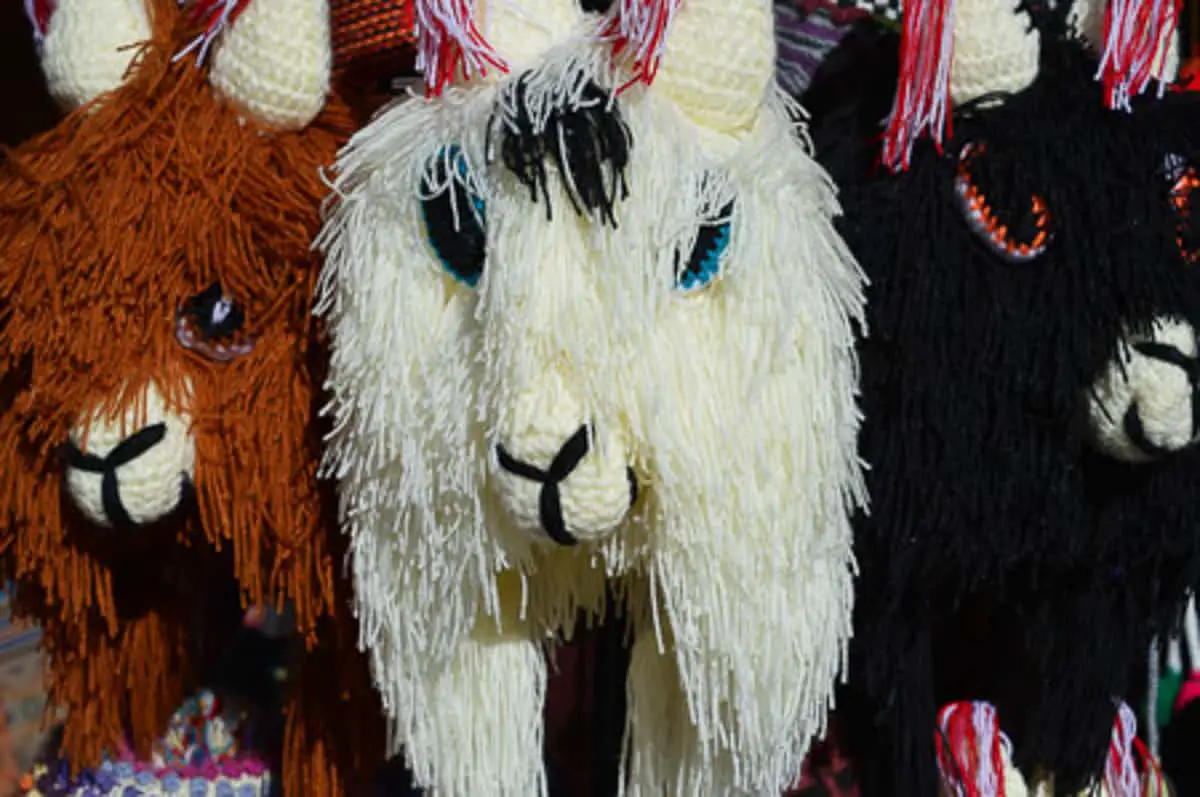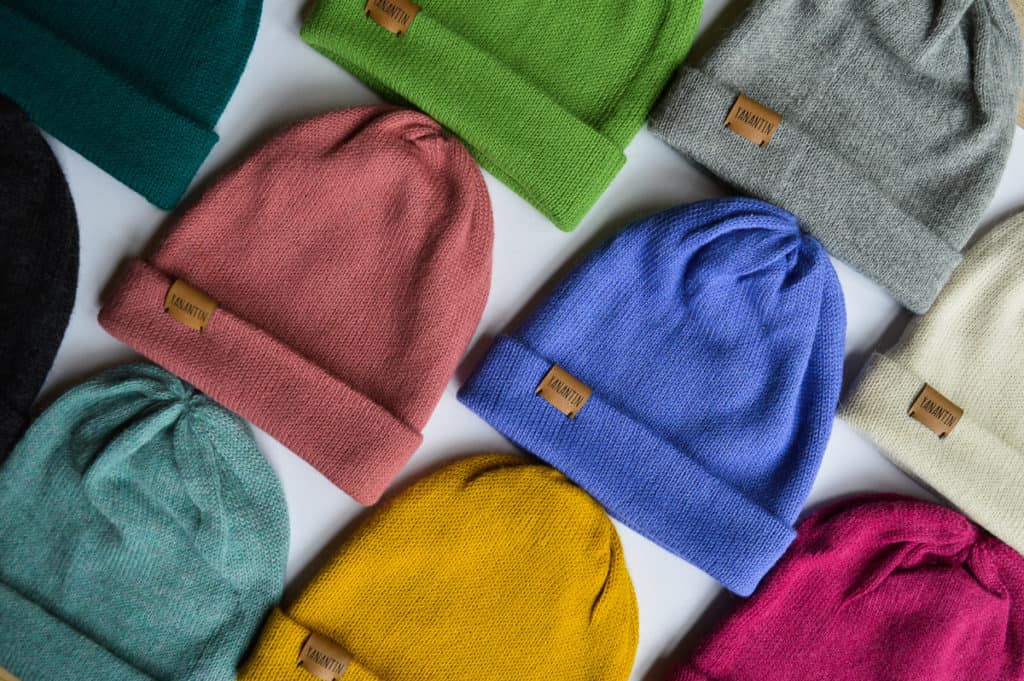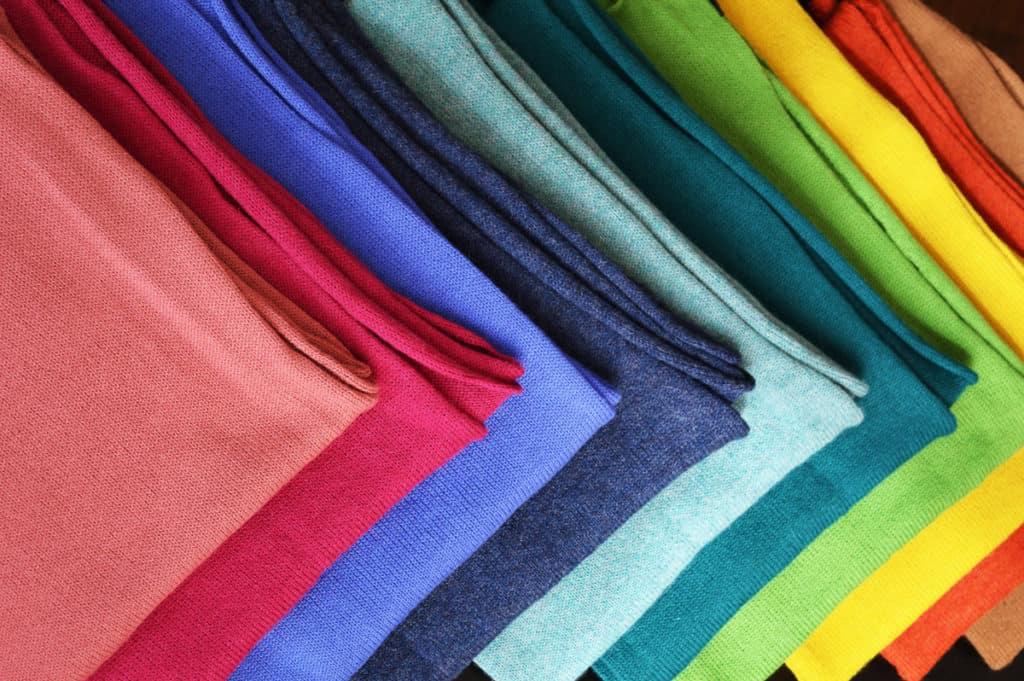Everyone who has visited South America is undoubtedly familiar with alpaca woolen products. Fashionistas and sustainable shoppers, you will probably have heard of this eco-friendly and luxurious fiber, too. For those of you who are new to the fluffy world of alpaca, you might wonder what else you can use alpaca wool for.
The alpaca fiber has insulating capabilities that make it the perfect material for a large number of things: from housing insulation to dryer balls, and from baby wear to exclusive fashion. Alpaca woolen garments can be used for all-season and all-weather purposes and are comfortable, sustainable and stylish.
Here is a list of 23 things that alpaca wool can be used for:
- Home insulation
- Hiking gear
- Summer wear
- Duvets
- Thermal underwear
- Dryer balls
- Socks
- Toys
- Felting
- Baby clothes
- Exclusive fashion
- Ponchos
- Ruanas
- Coats
- Knitting
- Sweaters
- Cardigans
- Hats
- Mittens
- Blankets
- Scarves
- Collar Scarves
- Shawls
How can you do and make all of these things with alpaca wool? Alpaca wool has insulating capabilities that are comparable to those of a house. In winter, a well-insulated house keeps the heat inside. In summer, it keeps it cool inside and keeps the heat outside.
Alpaca wool is therefore incredibly versatile and can be used for many different purposes: from crib to home, and from catwalk to mountain trail. Let’s take a look at this list in more detail.
1. Insulating Your Home With Alpaca Fiber
You can insulate your home with alpaca fiber. One of the most surprising uses of alpaca fiber, not the wool (which is the end-product of the fiber), is as insulating material for your house.
As I was researching the different uses of alpaca wool, I came across this awesome company, called AFICO, that uses the alpaca fiber as an eco-friendly and sustainable insulating material for homes!
Alpaca is a pretty recent discovery when it comes to insulating homes with it, but just like it works for sweaters and scarves, it works inside the walls of your house, too!
Alpaca wool is a sustainable alternative when it comes to insulation because of its insulation properties and many other reasons (according to AFICO):
- Very low flammability
- 100% natural
- Sustainable
- Acoustic properties (drowses out sound)
- Hypoallergenic
- Uses very little energy to manufacture
- Will not mold
- Is easy to install
2. Hiking Gear
You can go hiking with alpaca wool. Alpaca wool is a must have for all-weather hikes and outdoor activities.
When I lived in Cuzco, Peru, I used to go hiking often. Apart from the altitude (>11,000 ft), one of the hardest things about living there were the changes in weather and temperature.
The weather could be beautiful in the morning, with a blazing sun and no wind. Ten minutes later there could be a thunderstorm accompanied by a downpour and razing winds. Ten minutes later, you’d be soaked and the sun would be coming out again. Or not, and you’d still be soaked.
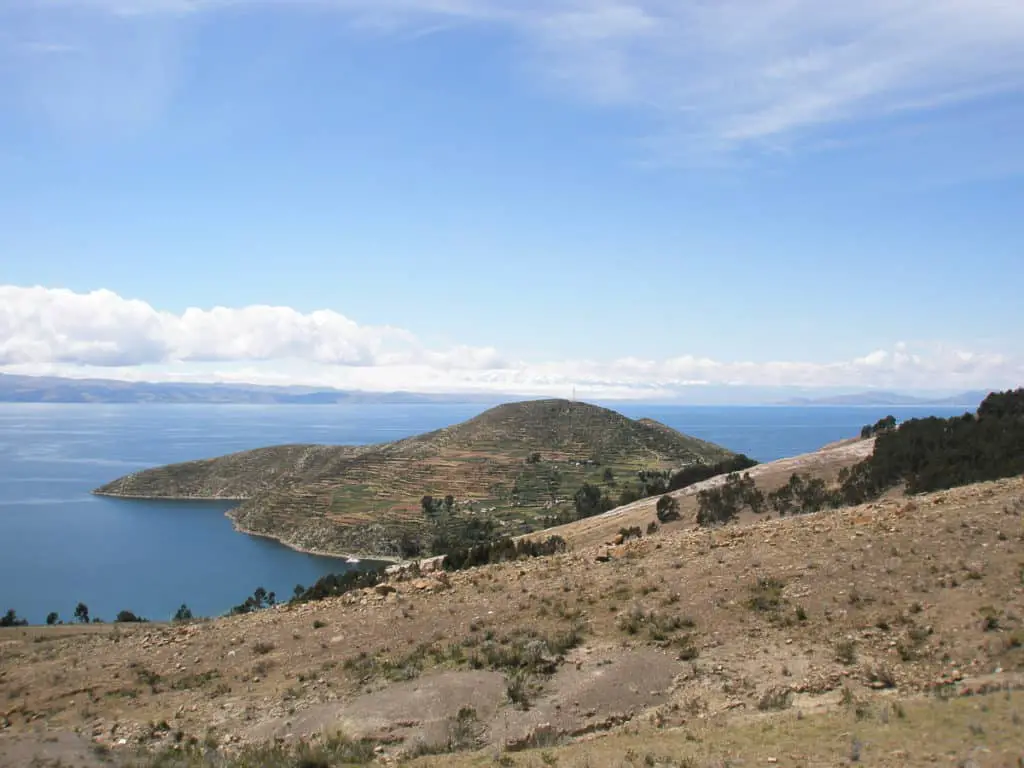
When you’re out hiking, you want to be prepared for everything. Especially when hiking in high altitude. Steep hills and uphill paths can cause you to sweat and feel hot, while the weather can be harsh or even cold. On the other hand, the sun might be warm or even burning, while the wind cuts your skin.
Layers are always a good idea when you’re hiking, but to prevent yourself from putting a sweater on and taking it off, and on and off, just to put it back on and take it back off again, you could try hiking with alpaca woolen clothing.
- Arms of Andes has beautiful alpaca woolen garments for outdoor events!
Not only is alpaca wool super lightweight, it is also adaptable to all those different kinds of weather. Alpaca wool is wind resistant, water repellent, and protects from direct exposure to sunrays. It is also breathable and both insulating and isolating. If it does get wet, alpaca wool will evaporate sweat and water without absorbing any of the odors.
The alpaca animal is native to the Andean highlands. Of course, the weather here is as unpredictable as you can expect it to be in mountainous areas. Mother nature has done a great job in providing the animal with a fiber that can handle literally every type of weather that you can imagine.

Alpaca wool is therefore a great, great recommendation for hikers and other outdoor adventurers who deal with swift changes in climate and weather.
3. Summer Wear
Now this might be a surprise to many of you with basic instincts. It was for me and it still feels weird… but it really is true: you can wear alpaca wool in summer.
This is because alpaca wool has the capability of maintaining the same temperature without being susceptible to changes in its environment.
Thermoregulation is the capability of the body to keep its temperature more or less consistent. The body is designed to do so even when the surrounding temperatures change.
Any item that is made of (pure) alpaca wool, will have great thermo-regulating capabilities. Because of the hollow fiber, alpaca wool can regulate temperatures. That means that when it is cold outside, it will maintain the body temperature and work to keep that temperature consistent and within the fiber.
It also means, that when it is hot outside, it will maintain the body temperature and prevent it from heating up.

The cool thing about alpaca wool is that it also evaporates sweat. So when your body is working to cool you down (aka, when you start to sweat), the alpaca fiber will not absorb the water, but will actually evaporate it. It stimulates the body to keep doing its natural things, without interfering with the process.
Alpaca wool does not conduct heat either. Imagine you touch something hot or cold; your body will absorb that temperature, especially if a larger surface of the skin is exposed to the source. Alpaca wool does not transfer heat (or cold), because it is a poor thermal conductor, (which is a good thing!).
So on top of being insulating, isolating and breathable at the same time, alpaca wool does not transmit changes in temperature, either.
4. Duvets
You can sleep under a duvet made with alpaca fleece. Have you ever touched an alpaca? If you have, you probably want one to cuddle up with during an afternoon siesta, right? A duvet made of alpaca fleece makes that dream almost come true.
For people with allergies. an alpaca woolen duvet may be an excellent solution to make it through cold nights. Alpaca wool is hypoallergenic, which means that it does not contain micro allergens that can cause allergic reactions. It is also free of lanolin, which can help people with wool allergy.
- I wrote an entire article about the hypoallergenic features of alpaca wool in this article Is Alpaca Wool Hypoallergenic (Lanolin Free)?
Alpaca wool is temperature regulating and sleeping under one of those covers will make all of your dreams come true! 🙂 Imagine a warm bed, a fresh room, a breathable cover and no sneezing, sweating, or cold feet.
Because alpaca wool is also thermal, it will maintain your bed cool during summer, too!
According to SlaapComfortWinkel.nl, there are many advantages to alpaca woolen duvets. Compared to sheep’s wool, an alpaca woolen duvet is:
- Lighter
- Warmer
- Hypoallergenic
- Cooler
- Breathable
- Better isolating
- Spreads warmth better
- Usable in summer, too
5. Thermal Underwear
You can use alpaca wool to make thermal underwear. Oooh, those times when it is cold and you’re putting on your thermals, and you’re so happy that you wear them, until you start moving actively, it gets hotter, too hot, you start sweating, it starts itching and you wish you had never put them on. Those times are over now.
Not all thermal wear will cause your body to sweat. Alpaca thermals are breathable, comfortable and itch-free for most people.
Poor quality thermals will not regulate the heat that it creates and will cause you to sweat. When your body cools down and the sweat gets absorbed by the fabric, or stays on your skin, it will make your body feel much cooler. And that’s not nice. Thermals are supposed to warm you up, and then keep you warm.
Alpaca wool does not absorb sweat and evaporates water that is formed (the fiber traps the heat, which works as a micro-heater). So it will quickly guide water (sweat) to leave the body through the fabric, rather than blocking it, leaving it on the skin, or absorbing it.
On top of that, alpaca wool is mostly itch-free, which makes it perfect for next-to-skin clothing. It depends slightly on the quality of the fiber, and on whether you have sensitive skin or not. In a nutshell, alpaca wool is around 24 to 30 microns, and most people don’t feel an itch from wool lower than 30 microns.
People with sensitive skin however, can feel an itch from anything more than 20 microns. Thermal underwear is often made with Royal Alpaca Wool (of approximately 18 microns).
- I wrote an entire article about whether or not Alpaca Wool is Itch-free. Read more about it.
6. Dryer Balls
You can use alpaca fiber to make dryer balls! As I was researching uses of alpaca wool, I found these awesome dryer balls from Alpacas of Montana. These are made of felted alpaca fiber, which means that they are made of the fleece, before it is spun to wool.
If you have access to unspun alpaca fiber, you can super easily make these funky balls from Instructables yourself and save your wallet, your dryer AND the planet detergents, softeners, and other harmful chemicals. HURRAY!
According to Alpacas of Montana, dryer balls are used to:
- Reduce wrinkles
- Eliminate static
- Shorten drying time
- Soften your clothes
Alpaca dryer balls are also:
- Environmentally friendly
- Durable
- Hypoallergenic
- Free of chemicals
7. Socks
You can make socks with alpaca wool. You will never ever have cold feet with a pair of alpaca woolen socks. Often used for hiking because of their air regulating qualities, or in-house (because they’re just sooo warm).
If you’re going for hiking socks, make sure you go for finely threaded socks, often some kind of blend. Despite what one might expect, alpaca woolen socks will not cause your feet to sweat, because they are breathable and insulating at the same time. Yes, this sounds counter intuitive, but it is true.
Alpaca wool has a special fiber that keeps warmth inside, cold outside, and does not absorb water or sweat. If sweaty feet do occur, it will evaporate the wetness quickly. Besides, the fiber will most likely not absorb any smells or odors, and can easily be aired out before you slip your feet into them again.
Another great feature is the strength of the wool. Since alpaca wool is very strong, it will last longer than other socks and will resist wear and tear longer.
The silky fiber is also soft and smooth, which helps to prevent friction. Especially for hiking, it is important to avoid friction at all times. Alpaca has this scale-like texture that makes it unlikely to cause friction.
For night-time and cocooning socks, I recommend the warmest, thickest, fluffiest socks you can find. Warm feet, foreveeeeeeeeeeeer. Keep in mind that the silky texture might cause the socks to slide down your feet. For that reason, you will often find alpaca woolen socks that have been blended with some time of other material, like elastic or acrylic fibers.
- Pssst! Baby Alpaca Woolen socks for Babies are being knitted AS WE SPEAK! Keep an eye out for them in my Webshop!
8. Toys
You can make toys with alpaca wool. YEEES and I’m not talking about toys in the shape of alpacas (which there are countless of, too, actually), I am talking toys that are made of alpaca wool (or felt).
People get super creative when it comes to DIY toys, and alpaca wool is a great example of it.
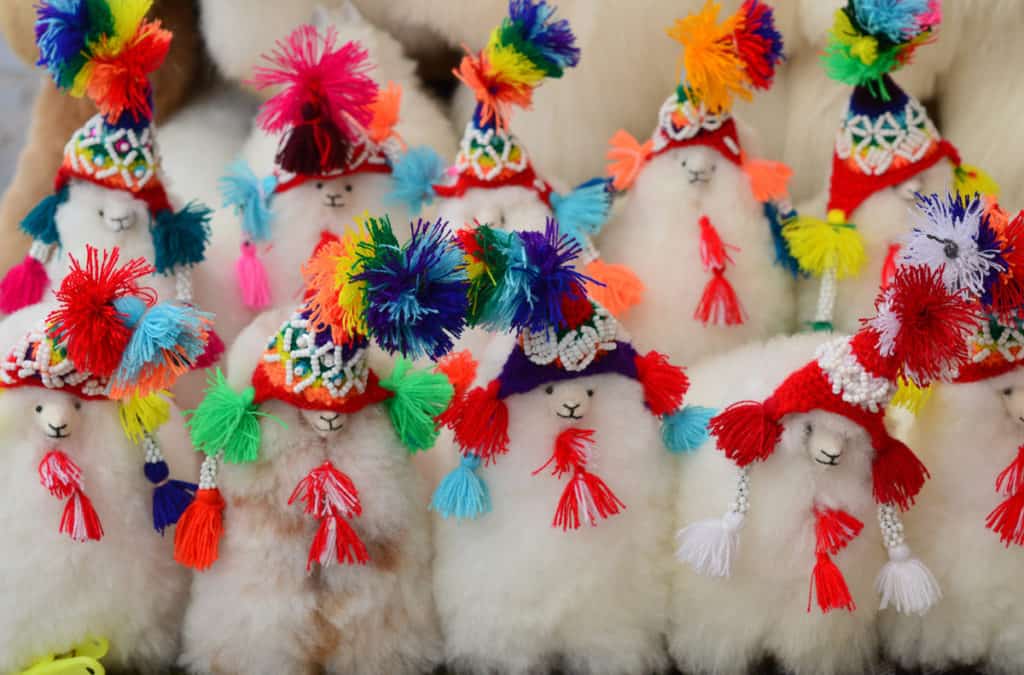
Since alpaca wool is hypoallergenic, super soft, and does not absorb any smells or stains, it is the perfect toy for children. So when your toddler feels that Mr. Stuffed Alpaca can use some spaghetti or shampoo, do not worry, it will survive.
Alpaca toys can be extremely durable because of their great quality material. Read carefully to see what your toy is made of and if it is 100% alpaca wool that has been used.
One downside of alpaca woolen toys, is that it could be using some wire on the inside. This of course, is hard, while you’d expect a stuffed animal to be soft.
Also, be careful with sewn on eyes or other tiny details that could be dangerous for young children.
9. Felting
You can make felt with alpaca wool. Felt is made by pressing fibers together until it becomes a strong textile that can be used for many different things. While felting can be a craft in and of itself, it can also happen accidentally when alpaca woolen garments are washed incorrectly.
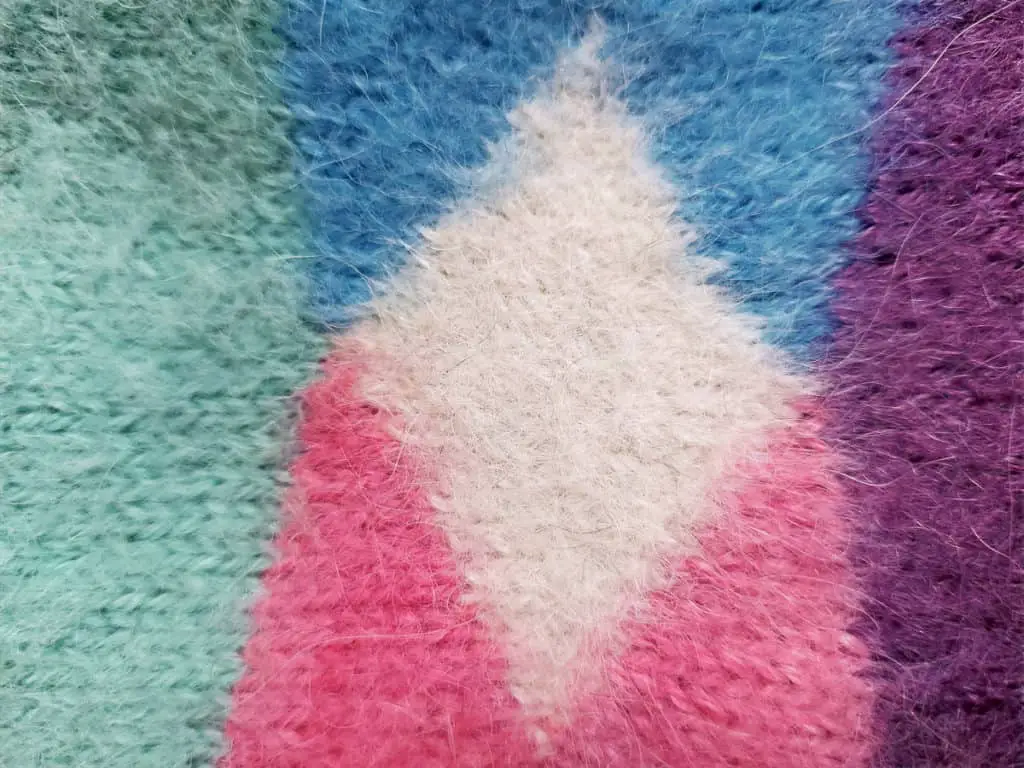
We have already seen the felt dryer balls and some toys, but you can do so much more with felt than that. In itself, this could be an entire list and article, so I’ll just explain quickly what felt is, and share some ideas of what you can do with it.
Felting is a natural process that occurs with wool when friction or heat damage the fiber. The wool or hair becomes harder and sturdier and loses a bit of its softness. This is not a good thing if you have a woolen sweater, or scarf, or other item, that you bought because of its softness. However, it can be a good thing if you want to use alpaca wool for other purposes, like handicrafts.
If you want to felt your own alpaca fleece, Alpacas of Montana offers some nice instructions on how to do that. You can also buy felted sheets ready to use online.
Other ideas of what you can do with alpaca felt are listed here:
- Purses
- Handbags
- Hats
- Mittens
- Stuffed animals
- Dryer balls
10. Baby Clothes & Accessories
You can wrap your baby in alpaca woolen clothes or accessories. Alpaca wool is incredibly soft, warm, and hypoallergenic. It is also itch-free, which is great for a baby’s skin. Alpaca wool is known to be softer than sheep’s wool, and since it is unlikely to leave an itch, it is perfect for our little ones.
Babies are not capable of regulating their own temperature as well as adults. Babies up to 18 months old can use a little help to maintain their body temperature stable. Plus, babies don’t have the glands to produce enough sweat to cool their bodies down when overheating.
As a result, babies need clothes and blankets that keep them warm and maintain their body temperature, without making them clammy and sweaty. Soft wool like alpaca wool, baby alpaca wool and merino wool – which are all known for their softness, warmth, and breathability – are perfect for this.
A baby’s sensitive skin will not be irritated by lanolin-free alpaca wool, it won’t get rashes from itchy fibers (make sure you go for unblended, high quality yarns), and they won’t get sweaty underneath a blanket.
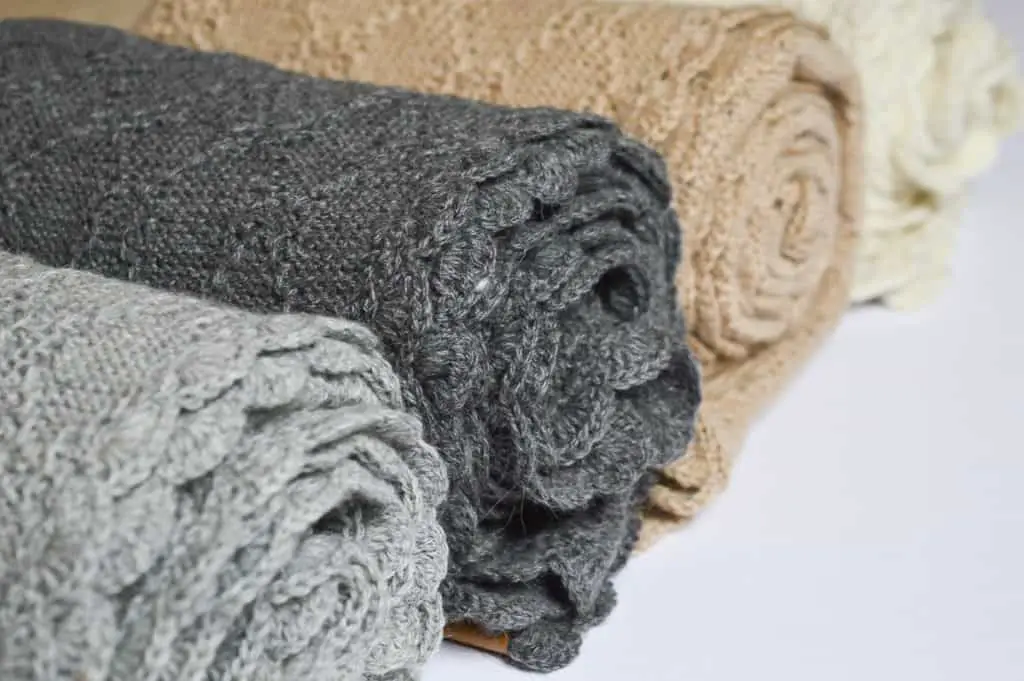
Check out the Yanantin Baby Blankets made with 100% Baby Alpaca
11. Exclusive Fashion
You can wear exclusive fashion made of alpaca wool. Alpaca wool is an exclusive fiber. It is not very common and it is not a widely used type of wool. It works perfectly with the supply and demand of it.
Because of this, alpaca wool is often used for high-end fashion that is high-quality, expensive and possibly with unusual designs. Many items are hand-made, with endless precision and attention to detail.
A lot of designers that work with alpaca wool are native to South America, and they will often integrate the details (colors, patterns, designs) of their indigenous roots into their design.
If you like extraordinary, unique and exclusive fashion, looking specifically into alpaca woolen garments can be an extremely interesting fashion-niche for you.
Please note that alpaca wool does not have to be expensive or exclusive. In fact, I wrote an entire article about this and I recommend you read this to understand the price of alpaca wool: Is Alpaca Wool Expensive?
12. Ponchos
You can wear ponchos that are made of alpaca wool. The classical use of alpaca wool is, of course, a poncho. You see people in the Andes wear ponchos, which are cape-like garments, with beautiful patterns and colors. Ponchos in South (and Latin) America are used as coats. They’re comfortable, flexible and warm.
You will often find these capes made of sheep or alpaca wool, probably made from the fleece of the people’s own animals!
If a poncho is made of alpaca wool, it will not only be warm, but also wind and rain resistant. In the Andes, this is a very important feature of the poncho, because the weather can be unpredictable (but if you were going to predict it, it would be cold, windy and wet).
The qualities of alpaca wool make a poncho the perfect garment to have, and its use is as versatile as the wool itself. Made in the most beautiful colors, a poncho is a real eye-catcher!
13. Ruanas
You can wear ruanas made of alpaca wool. For those of you who love the idea of a poncho, but would like something perhaps a little less Andean, and a more classical look, a ruana is a great, great, great, alternative.
A ruana (Wikipedia) is similar to a poncho but is open in the front, and can be worn in more different ways. Most ruanas nowadays are very exclusive fashion items and are often made of luxurious baby alpaca wool. You can wear them fashionably with a belt or with one of the sides tipped over the shoulder. A ruana is definitely an item of status and luxury!
14. Coats
You can wear coats made of alpaca wool. Thanks to its water repelling qualities, alpaca wool can be perfectly used for coats and jackets. Especially compared to down jackets, a woolen coat can actually get wet and still be warm. Alpaca wool has the capacity to wick away moisture before the fiber can absorb it, and will evaporate water quickly to prevent it from soaking.
Another advantage of an alpaca woolen coat is that it is much lighter than sheep’s wool, and therefore even more comfortable to wear.
From bomber jackets, to buckle coats and classy trench coats… You can find woolen coats in all styles and sizes. And price tags! Given that alpaca wool comes directly from an animal, it is important to know what the source of your brand is. Invest in sustainable, eco-friendly and animal-friendly brands.
15. Knitting
Perhaps the most obvious answer on this list: of course, you can knit with alpaca wool. Alpaca wool is a beautiful, luxury yarn that you can perfectly use for knitting and making your own items. Doing a bit of the hard work yourself will make alpaca woolen items cheaper and more in line with your personal style.
Keep in mind that knitting with alpaca wool is different than other types of wool. Alpaca wool has a silky feel to it, making it difficult for inexperienced knitters to deal with. While some people chose to avoid knitting with alpaca wool complete, there are ways to get acquainted with the wool.
According to LB Handknits, alpaca wool is perfect to knit drapelike designs:
- Choose a seamless design
- Choose an item that has a flowing design (cardigan, tunic, pullover or dress)
- Work with a looser gauge
Another benefit to teaching yourself to knit, is that when you don’t like or fit an item anymore, you can easily unravel a piece and reuse its yarn! Alpaca wool is strong enough that you can easily recycle it!
16. Sweaters
You can wear alpaca woolen sweaters. A classic souvenir from Peru is a fluffy knitted sweater with Andean patterns and motifs. You can’t go wrong with an alpaca woolen sweater when it comes to the basics of your wardrobe. An alpaca woolen sweater comes in countless beautiful colors, patterns, designs and styles.
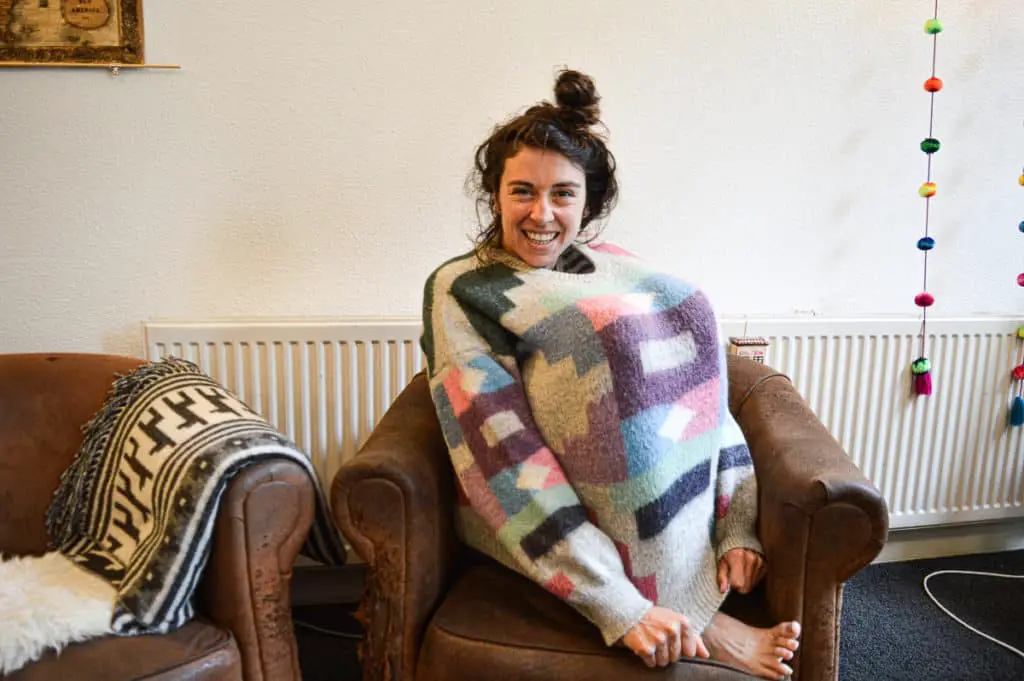
Closer to the source (Peru) you will find alpaca woolen sweaters for lower prices (although not necessarily) and more eccentric designs (Andean – colorful and full of patterns). Other, perhaps more internationally oriented brands can provide sweaters that are more in line with the latest fashion trends or even more neutral.
17. Cardigans
You can wear alpaca woolen cardigans. Of course, cardigans are another great asset in your closet and can even be more versatile than sweaters.
The difference between cardigans and sweaters is the opening in the front. Cardigans can be opened and closed with a zipper or buttons.
Of course, you can buy alpaca woolen items. For the creative ones among us, you can also knit alpaca woolen sweaters and cardigans. The Alpaca Yarn Company is a great source of inspiration when it comes to knitting patterns.
18. Hats
You can wear alpaca woolen hats. When I think about wool, I think about hats. I love hats. Especially in winter. But also in spring, and fall. And in summer. Alpaca woolen hats are amazing: they are extra warm, don’t let any wind go through to your head, are super comfortable and adapt to your head without losing shape.
While some hats can cause itchy heads (to my head at least), because of the boiling heat that my noodle apparently creates, alpaca wool is extremely breathable and will not cause such discomfort.
Another possible disadvantage to alpaca woolen hats is that they are so isolating, that they can actually drown out sound.
Together with mittens and scarves, hats form an essential trinity of winter wear. The basics to get started in a cold climate are to protect your head, throat and hands from the cold.
Check out the awesome Yanantin Alpaca beanies that are made of 100% alpaca wool.
19. Mittens
You can wear mittens with alpaca wool. Fingerless mittens, regular mittens, gloves… You name it, your hands will not be cold when they are protected with alpaca woolen knitwear.
Just like any other item made of alpaca wool, mittens will be wind and water resistant, warm, soft, and super comfortable!
Mittens and gloves are the kind of accessory that you can make yourself, too. A fun DIY project to try out some alpaca wool could be to get yourself started on making mittens. At Cascade Yarns I found a ton of inspiring patterns of different types of gloves and mittens.
20. Blankets
You can travel with alpaca woolen blankets. I have a couple of small alpaca woolen blankets that I brought with me while I was travelling in South America. Bus rides, plane rides, waiting at terminals… With an alpaca woolen blanket you are prepared to sleep anywhere.
The BIG advantage of travelling with a light blanket like an alpaca woolen one, is that it is light, yet super warm! Alpaca wool has this great feature of a hollow fiber, which makes it insulating and isolating at the same time, without making it heavy or bulky.
On top of that, it is very stain and odor resistant and you will be able to travel for hours without your blanket getting stuffy or smelly.
21. Scarves
You can wear scarves that are made of alpaca wool. A scarf is smaller than a shawl and therefore more used as clothing that can protect you from the elements. An alpaca woolen scarf will protect you from literally every element with its wind and water resistance.
A scarf can be a great addition to keep your neck and throat protected during cold days. Scarves are often long and can be wrapped multiple times around the neck.
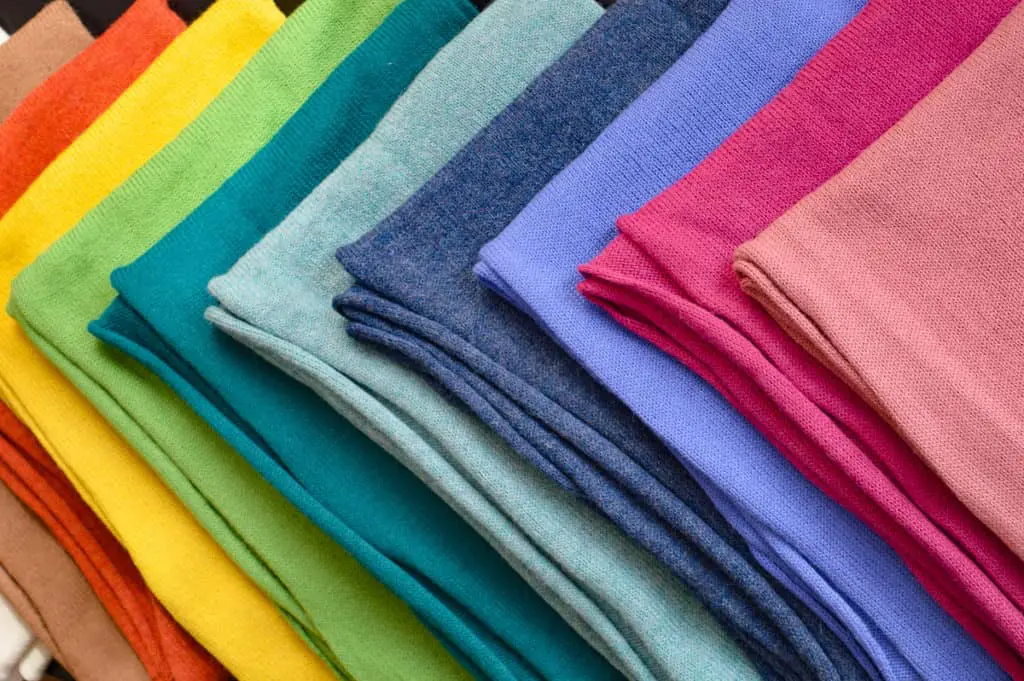
Check out every single one of these colorful scarves in my Webshop!
22. Collar Scarves
You can wear a collar scarf made of alpaca wool. Collars come in two types of designs: fashionable or practical. They are also known as loop scarves, infinity scarves or col scarves.
The fashionable collars are gorgeously decorated clip-on accessories that you can use to give your outfit a boost – while staying warm.
- Practical collars are more geared towards hikers or people who exercise outdoors and are simple yet very, very practical. The benefit of a collar compared to a shawl is that they are super small and give more freedom to move the neck. They don’t have the extra fabric that can be in the way when you are moving a lot.
According to Vision Times, the protection and warmth that collars provide can even alleviate sore muscles!
23. Shawls
You can wear shawls of alpaca wool. As versatile as alpaca wool itself, shawls come in many sizes and colors, shapes and models. From a shoulder covering wrap or a neck protecting collar… A shawl of alpaca wool will keep you warm no matter your style.
The big benefit of shawls is its versatility. My alpaca woolen shawl goes with me from winter through summer, on hikes and dinner parties, matches my pyjamas and keeps my legs warm watching movies. Really, there is no occasion or reason that excludes my shawl.
Check out Yanantin’s sustainable XL shawls made of 100% alpaca wool. They come in a rainbow of colors and contribute to women’s empowerment in Bolivia.
Why Is Alpaca Wool Versatile?
The alpaca fiber is usable for many different purposes, climates, circumstances, etc. Alpaca wool has a hollow fiber, which helps it to be incredibly warm and insulating. The alpaca fiber works to make and maintain a body warm.
You can compare alpaca wool to an insulated house: the layer of alpaca wool keeps everything underneath it warm, while keeping the cold outside. On the other hand, you could use alpaca wool in summer: when the heat is kept out while a cooler temperature is maintained on the inside.
On top of that, alpaca wool is a poor thermal conductor, which means that it does not transmit changes in temperature.
Alpaca wool is also wind resistant, water repellent, and protects from direct sunlight.
Despite being insulating, alpaca wool still has an incredible breathability. The fiber of the alpaca hair is hollow, with little micro bags of air inside. The air is trapped in here, which creates the protection from wind, rain and changing temperatures.
A solid fiber would make the fabric very little breathable, causing sweaty, hot and clammy bodies. This is not the case for alpaca wool.


